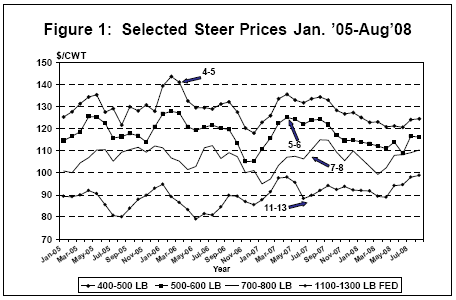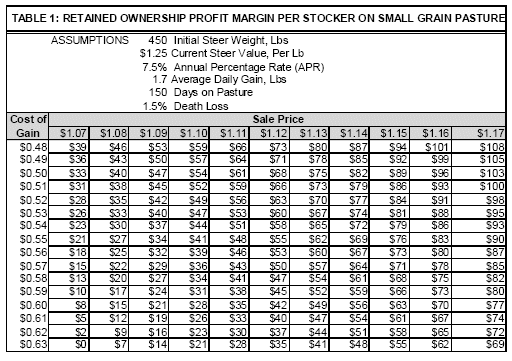AG-ECO NEWS
Vol. 24, Issue 24, August 25, 2008 – PDF version
Jose G. Peña
Extension Economist-Management
Relatively Attractive Cattle Feeder Prices are Attracting Interest in Cattle Retained Ownership Enterprises; High Calf Values and Market Risk Will Require Enterprises to Be Carefully Planned and Monitored
Relatively attractive prices for feeder cattle in relation to calf price is causing interest in retained ownership enterprises this fall/winter/spring season (see figure 1). High feed costs are continuing to increase market vulnerability indicating that retained ownership enterprises will carry high risk.  Current market prices appear to indicate that retained ownership enterprises this fall/winter may be profitable, partially because price roll-backs of 8-10 cents appear more manageable when compared to the typical roll-backs of 15-20 cents between current calf and feeder prices. The shortage of forage as a result of the continuing drought, high costs of gain even on small grain pastures this fall/winter/spring and the vulnerability of the market as a result of high grain prices also indicates that retained ownership enterprises will carry high risk and will require careful planning and monitoring.
Current market prices appear to indicate that retained ownership enterprises this fall/winter may be profitable, partially because price roll-backs of 8-10 cents appear more manageable when compared to the typical roll-backs of 15-20 cents between current calf and feeder prices. The shortage of forage as a result of the continuing drought, high costs of gain even on small grain pastures this fall/winter/spring and the vulnerability of the market as a result of high grain prices also indicates that retained ownership enterprises will carry high risk and will require careful planning and monitoring.
Forage Availability
While recent excellent rain in parts of Texas may indicate that the forage situation may improve, the severe drought during the last twelve months, not to mention that pastures/ranges have not recovered from the severe 2005/06 drought, has decimated pastures and ranges. Even if above average rainfall is received this fall, except for a few isolated locations which received excellent rain, there is not sufficient time left this fall to produce sufficient forage to sustain a viable retained ownership enterprise.
Forage production from small grains and ryegrass may be very limited unless pastures are irrigated. Also, while the going rate of cattle gain contracts on small grains was about $0.35-$0.45/lb of gain, these prices will likely increase substantially, primarily due to increased rye/small grain crop production costs, especially energy and fertilizer costs. As a result, it appears that in addition to high market risk, retained ownership enterprises this year will also carry higher than average production risk as a result of the continuing drought and higher costs of production and will require careful planning, monitoring and a review of alternatives. Alternatives include comparing the value of calves now versus the potential additional profits from retaining owned calves and/or buying calves to carry through the stocker/feeder phase on native, small grain or ryegrass pastures and/or a feedlot.
Lower Cattle Inventory
One of the factors that are keeping calf and feeder prices high is the low number of cattle available. The U.S. cattle inventory on July 1, 2008 decreased about 900,000 head from July 1, 2007. The 2008 calf crop is estimated at 37.25 million head, down 111,000 head from a calf crop of 37.361 million in 2007 and down 269,000 head from a calf crop of 37.519 million head in 2006. Feeder supplies will remain in short supply unless feeder cattle imports from Mexico increase.
Scarce supplies of cattle will keep upward pressure on prices, especially for feeder cattle ready to enter feedlots as feedlots are operating below capacity. USDA’s July 25, 2008 Cattle on Feed report indicated an inventory of 10.295 million head on feed on July 1, 2008, down 4.1 percent from 10.737 million head on July 1, 2007 and down 5.3 percent from two years ago. Cattle marketings as of the end of June ’08 were down 7.8 percent from a year ago and down 10.2 percent from two years ago. With feedlots operating at significantly below capacity, coupled with high costs of gain, feeder cattle prices are being bid-up at the expense of prices for calves.
Ample Supplies of Competitive Meats
Meanwhile, meat supplies are up, providing consumers a wide variety of choices. USDA’s August 12, 2008 estimate of red meat production for 2008 (beef, pork, veal, lamb and mutton) at 50.691 billion pounds was up 3.8 percent from 48.817 billion pounds produced last year. Poultry production at 43.268 billion pounds was up 2.7 percent from 42.117 billion pounds produced last year. The August ‘08 estimate of this year’s beef production at 26.79 billion pounds was up slightly from 26.523 billion pounds produced last year. The average live weight for cattle slaughtered was 1,276 pounds, up 4 pounds from average slaughter weights of 1,272 pounds a year ago.
Feedgrain Prices
While prices for corn weakened after record highs in June-July 2008, prices are still in the $6.00 or more per bushel range, translating to expensive feed costs. USDA=s first survey based crop production forecast for 2008, released on August 12, 2008, estimates that corn production for the 2008/09 season at 12.288 billion bushels is up 573 million bushels (4.9%) from last month’s estimate of 11.715 billion bushels, but down six percent from last year’s record crop of 13.074 billion bushels. If realized, this will be the second largest crop on record. Increased domestic use, especially for ethanol production continues to fuel the market. While prices for corn are lower than recent record highs, futures prices on the Chicago Board of Trade (CBOT) are trading at $6.18/bu (December ’09) to $6.64/bu (September ’08) for most ’08 and ’09 contracts. USDA’s August ‘08 average price range for corn was projected at $4.90 to $5.90 per bushel, down 60 cents on both sides of the range from last month’s estimate.
The price of cost of gain contracts on winter forages varies widely depending on the quality of the forage. High feedgrain prices, forage shortages due to the drought and high production costs are influencing price bids for forage. Prices vary from a low of about $0.45/lb of gain to as high as $0.70/lb, depending on the forage quality and the services provided.
Stockers Retained Ownership Profit Margin
A retained ownership enterprise and/or buying stockers this fall will provide an opportunity to add value to the calves through additional gain from relatively manageable forage and/or cost of gain through a feedlot (in relation to market prices). Keep in mind that strong current demand and cattle shortages are keeping cattle prices up, especially for calves. So, the enterprise would require a relatively high initial investment in terms of the current value of calves.
With four to five weight #1 and #2 grade calves trading in the $1.20-1.30/lb range compared to cattle-feeder futures contracts for January ‘09 through August ‘09 delivery trading at about $1.12/lb, in the Chicago Mercantile Exchange, price roll-backs will continue to play an important role in a retained ownership enterprise. If good quality forage is available at affordable prices, stocker retained ownership enterprises this winter could be profitable if properly planned, managed and monitored. The feedlot option, while probably less risky from a production viewpoint, may carry higher financial risk.
The accumulated cost of the calves, their current market value and the owner’s financial situation should serve as the benchmark to evaluate the profit potential and risk associated with a retained ownership enterprise this coming winter. Keep in mind that retaining ownership will increase management and decision-making requirements. More capital will be required for the additional production expenses and annual cash flows will change because retaining ownership will delay income and add production costs.
Table 1 provides an estimate of potential profits for a 450 pound steer with a current value of $1.25/lb, by varying the cost of gain and the sale price next spring (150 days on small grain pasture). 
If, for example, the total cost of gain averages $0.55/lb, at 1.7 lb average daily gain (adg) for 150 days, and the steers are sold at the current futures price quote for April ‘09 delivery ($1.12/lb), a rancher could average about $55/head in profits. Similar profit opportunities may not work in native pasture since the rate of gain and the days left before a killing frost may be limited.
